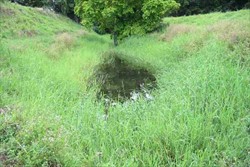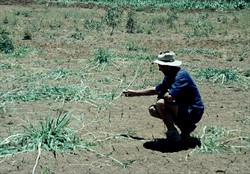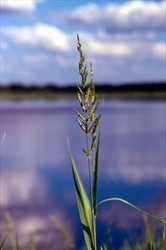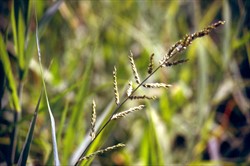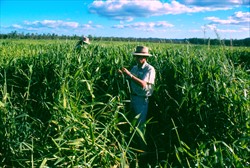Tropical Forages
Echinochloa polystachya (Kunth) Hitchc.
Subordinate taxa:
Echinochloa polystachya (Kunth) Hitchc. var. polystachya
Echinochloa polystachya (Kunth) Hitchc. var. spectabilis (Nees ex Trin.) Mart. Crov.
var. spectabilis: Basionym: Panicum spectabile Nees ex Trin.; Echinochloa spectabilis (Nees ex Trin.) Link
Family: Poaceae (alt. Gramineae) subfamily: Panicoideae tribe: Paniceae subtribe: Boivinellinae.
Echinochloa polystachya is an aquatic or sub-aquatic perennial with coarse culms 1–2.5 m high, thick in the lower parts, from long rhizomes, internodes glabrous, nodes glabrous or obscurely pubescent. Ligule a rim of stiff, yellow hairs to 4 mm long. Leaf blades 20–60 cm long, 10–25 mm wide, scabrous on the margin. Panicles mostly 15–25 cm long, with ascending side-branches (racemes), 2.5–11.0 cm long. Spikelets 5–7 mm long, lanceolate. Upper floret hermaphrodite, 5–6 mm long, with awn 5–7 mm long or mucronate; lower floret staminate with awn on lemma 7–17 mm long.
‘Amity’, the only released cultivar of the species, differs from the botanical species norm in having flowering culms 100–200 cm long, 7–10-noded, nodes glabrous. Ligule hairs 1–1.5 mm long. Leaf blades 30–36 cm long, 10–12 mm wide. Panicle axis 20–30 cm long. Spikelets 4.5–5.5 mm long, 1.7–2.0 mm wide. The most distinctive differences are the much shorter mucros of the lemmas of ‘Amity’; the lemmas of are normally awned rather than mucronate. ‘Amity’ has flat linear, glabrous leaves, tapering to a narrow apex, rounded or auriculate at the base. Panicle axis scabrous; primary branches with spikelets appressed to the rachis, 2.5–9.0 cm long. Pedicels 0.2–2.0 mm long, scabrous, disarticulation at the base of the spikelet. Spikelets plano-convex, lanceolate. Lower glume 2.5–3.0 mm long, ovate-lanceolate. Upper glume 4.5–5.5 mm long, lanceolate 6–7-nerved, chartaceous, glabrous, strigose on the nerves apically, acuminate, 5.0–5.5 mm long. Lemma of lower floret 5.0–5.5 mm x 1.0–1.5 mm, lanceolate, chartaceous, 7–9-nerved, the surface glabrous, acuminate, with mucro 1.0–1.5 mm long; lower palea linear, acute. Upper floret lemma 4.5 mm long, white, cartilaginous, smooth, ovate-lanceolate, acuminate, with mucro 0.5 mm long; upper palea cartilaginous, smooth, enclosed at its apex by the lemma.
English: Aleman grass, German grass (Australia), carib grass, creeping river grass (North America); Angola grass, Habetz grass, mudflat millet, perennial barnyard grass, water Bermuda
Latin America: canarana de praia, canarana peluda, canarana verdadeira, capim caiana, capim cavalha, capim fino, capim-mandante, capim Paraguai, Janeiro (Brazil); paja pelua, pasto alemán, pasto chigüirera (Venezuela, Guyana); pardegrao, prasigrasi (Suriname); hierba de corzo (Cuba); hierba de Cayena, pelillo, hierba del corso, Janeiro, zacate alemán, zacate de Angola (Spanish)
Native
Northern America: Mexico, USA (Florida, Louisiana, Texas)
Caribbean: Antigua and Barbuda, Cuba, Dominican Republic, Haiti, Jamaica, Martinique, Puerto Rico, St. Lucia, Trinidad and Tobago
Central America: Belize, Costa Rica, Honduras, Nicaragua, Panama
South America: Argentina, Bolivia, Brazil, Chile, Ecuador, French Guiana, Guyana, Paraguay, Peru, Suriname, Uruguay, Venezuela
Cultivated/naturalized:
Africa: Tropical and southern Africa
Asia: Tropical
Australasia: Australia (Northern Territory, Queensland)
Pacific: Hawaii
Forage
Permanent grazing in natural wetlands or ponded pastures producing large yields of palatable fodder. Used for grazing, silage and hay in Central America. Grown in ponded pasture systems in subtropical Australia, in water up to 2 m deep for short periods but normally to 1 m, to complement para grass ( Urochloa mutica), which will grow in water to 30 cm depth.
Soil requirements
Tolerates a wide range of soil fertility, but best on soils of medium to high fertility. In Colombia, found on clay soils. It is adapted to soil pH 4–8 and has some tolerance of sodicity. Very tolerant of poor drainage.
Moisture
Natural habitat is seasonally flooded wetlands, but can grow under very high rainfall (>1,900 mm/year) conditions. Generally no growth under dry conditions unless there is a high water table, but re-establishes from stems and stolons with subsequent flooding. Normally grown in water to 1 m depth but can persist for short periods in deeper water to 3 m. Grows best in wet or seasonally flooded areas, where flooding can occur for 7–12 months of the year.
Temperature
Summer growth only, no frost tolerance but often protected from overnight frosts by surrounding volume of water. Grows best in an altitudinal range of 0‒1,200 m asl.
Light
Shade tolerance not known.
Reproductive development
Seed production is poor with few viable seeds developing. Seed heads are produced throughout the year when plants have stems longer than 1 m.
Defoliation
Very palatable grass but access by livestock may be limited by depth of water. Cattle get access as seasonal flood levels recede. Can be grazed, or conserved on dried soil surfaces. Cutting below 40 cm reduces yield. Supports high stocking rates with rotational grazing with 45-day rest.
Fire
Not normally applicable due to moist/wet conditions but will recover from mild fires from stems and rhizomes.
Guidelines for establishment and management of sown forages.
Establishment
Since seed yields and quality are very low, aleman grass is normally planted from stem or stolon cuttings (1–2 t/ha) at spacings of 1–4 m between and within the rows. Stem sections with 2–3 nodes are planted with 1 node above the surface. They can be planted manually into wet mud or dropped into the surface of shallow water and pushed into the soil by special wheels on a light-weight tractor. Establishment is most successful where competition from existing vegetation has been removed.
Fertilizer
Not normally fertilised as it relies on nitrogen mineralised by fluctuating soil water, rapid decomposition of organic matter and by the activity of nitrogen-fixing organisms in the root zone of the grass. However, it can be very responsive to high levels of N fertilizer.
Compatibility (with other species)
Not generally compatible with other species due to flooded conditions.
Companion species
Complements para grass ( ) (water to 30 cm deep) and Hymenachne amplexicaulis (water deeper than 1 m) in ponded pasture systems.
Pests and diseases
No serious insect pests in Australia but likely to be affected by fungi that infect other native Echinochloa grasses, e.g. smuts (Ustilago tricophora) and leaf spots due to Bipolaris spp., Cercospora spp. and Curvularia lunata.
Ability to spread
Spreads easily in wet places from broken pieces of stem and stolon carried by water.
Weed potential
Like other water grasses, it can spread into wetlands to form mono-specific stands that smother native species. Although rated as very useful fodder in the native wetlands of tropical America, it is regarded as a potential significant environmental weed in some other countries. Aleman grass is no longer recommended for new planting into wetland areas of Queensland, Australia. Considered a weed in crops such as rice.
Nutritive value
Comparatively high nutritional value (especially during the dry season when dryland grasses have matured into very low quality feed). Fresh material has yielded 30% DM with <10–18% crude protein (up to 22% CP in fresh leaf). Digestibility generally 50–63%; up to 74% has been recorded in fresh growth.
Palatability/acceptability
Very palatable and eagerly sought by cattle.
Toxicity
None recorded.
Feedipedia link
Dry matter
DM yield ranges of 8–50 t/ha/yr are reported from South America, and 10–20 t/ha/yr from northern Australia.
Animal production
Average daily liveweight gains of about 0.5 kg/day at stocking rates of 0.2–1 ha/animal with 700 kg LW production/ha have been recorded off irrigated or rain-fed pasture but little data is available from ponded pasture systems. However, the critical benefit from ponded systems is the ability to fatten/finish stock into the dry season when dryland native pastures have matured. In Venezuela, 310 g LWG/animal/day have been obtained; in Mexico, at a stocking rate of 2‒4 animals/ha, 360‒540 kg LW production/ha/yr.
2n = 54.
Produces little viable seed, with no evidence at all of viable seed being produced in northern Australia.
No information available.
- Can grow in standing water to 3 m deep, but more generally to 2 m.
- High quality feed during cool dry season with ponding.
- Tolerates high stocking rates under rotational grazing.
- Little or no seed but spread from pieces of stem.
- Cannot tolerate low rainfall or drought.
- Potentially a major environmental weed in wetlands.
Farias, M.L. and Piedade, M.T.F. (2002) Growth and biomass of Echinochloa polystachya (Poaceae) under nitrogen fertilization and different harvest treatments. In: Lieberei, R., Bianchi, H-K., Boehm, V. and Reisdorff, C. (eds) Neotropical Ecosystems. Proceedings of the German-Brazilian Workshop, Hamburg 2000. p. 913–916.
Filgueiras, T.S. and Rodrigues, R.S. (2016) Echinochloa polystachya (Capim-de-Angola). In: Vieira, R.F., Camillo, J. and Coradin, L. (eds) Espécies Nativas da Flora Brasileira de Valor Econômico Atual ou Potencial: Plantas para o Futuro ‒ Região Centro-Oeste. Secretaria de Biodiversidade, Ministério do Meio Ambiente, Brasília, DF, Brazil. p. 617‒619. https://bit.ly/2UMZUzo
Pittaway, P.A., Wildin J.H. and McDonald, C.K. (eds) (1996) Beef production from ponded pastures. Occasional Publication No. 7. Tropical Grassland Society of Australia, Brisbane, Australia. hdl.handle.net/102.100.100/225842
‘Amity’ (CPI 61147) Released in Australia (1988). Collected in the Orinoco Delta, Venezuela as an alternative to para grass for ponded pastures with the ability to grow in deeper water (up to 2 metres). Now considered a major weed threat in northern Australia because it can grow in even deeper water than Hymenachne amplexicaulis.
None reported.
